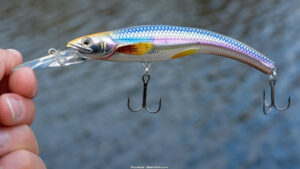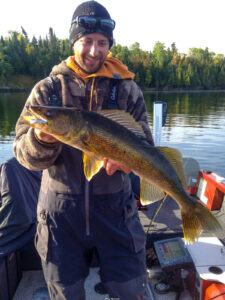Any walleye angler worth their weight in salt knows these fish are edge oriented. Walleye flock to sand-rock transitions, weed edges and, of course, ledges. Come fall, deep ledges are common walleye hang outs, but finding a decent-looking ledge doesn’t guarantee a limit.
Ontario’s Dave Bennett knows a lot about fishing ledges. With 20 years guiding experience on the structure-rich Lake of the Woods, he’s spent countless hours fishing steep breaks. In this time, he’s learned why certain ledges are great, while others are ghost towns in fall.
He offers these 4 tips for finding productive ledges and consistently catching walleye from these stair-step structures:
- Find the food
- Scan and fish
- Go vertical
- Clean up with cranks
“When it’s fall and cold out, the last thing I want to do is stick my hand in a minnow bucket. They’re a last resort if I can’t get a bite on anything else.”
Find ledges near food
The most consistent ledges Bennett fishes are those rising from deep water to shallow to mid-depth weedy bays and flats. These areas provide summer habitat for young of the year yellow perch and minnows. Bennett’s top areas are near mainland points, beside channels, along island shorelines and in large bays.
The scene changes in fall. Cooling temperatures cause perch and minnows to move towards deep flats and basins where they’ll spend the winter. If the top of the ledge has healthy weeds or is adjacent to a sizable flat with moderate depth, perch and minnows may linger here until late fall or winter. Otherwise, they must travel the ledge before reaching deep water. Each situation causes a sudden concentration of forage near the ledge.
“Walleye move in from deep basins to ledges to attack perch and baitfish. In August, I could get 50 walleye off a mid-lake hump. Not in the fall. A lot of those fish have moved right up to the base of the drop of the ledge,” Bennett said.
This is why Bennett focuses on ledges close to deep, walleye summer habitat. When the seasons shift, the best ledges are often the ones walleye don’t have to travel far to reach.
Scan first, fish second
Ledges are big structures. There can be a lot of unproductive water between walleye spots. Use electronics to locate prime areas.
- Faster than fishing – “Being able to drive 3.5 to 5 miles per hour along a big ledge, like a shoreline break, and identify key features on it using Side Imaging is a huge time saver compared to fishing the entire thing to find the best spots,” Bennett said.
- Waypoint features – While Side-Imaging, Bennett enters waypoints of key features into his Humminbird 1198. Boulder piles, stair steps, a finger, a steep break and an inside turn are examples of what can concentrate walleye along a ledge.
- Take another look – After the initial scan, Bennett backtracks. Operating at a slower pace, he uses Down Imaging / Sonar Combo view to look for fish on the waypoints.
- Pay attention to depth – Determining walleye’s preferred depth range is an important step. It helps focus on productive areas and further refine tactics. Wind-created current, sun position and light penetration, among other things, will influence their depth on the given day.
Boat position and vertical tactics
Once fish are located, boat control is critical. Being off a spot by as little as 10 feet can put an angler out of the strike zone of walleye on a small stair step. This is one reason Bennett runs a tiller boat, specifically the Kingfisher Flex 2025 TL. The immediate and precise control of the tiller lets him hovers over a pod of walleye or a GPS waypoint.
- Stop and drop – “I like a tiller boat for the ability to stop and drop on a real specific spot. It’s a fun and easy way to fish. You’re looking at the electronics and cruising the ledge. When you see fish, put the motor in reverse to hover over them, drop down a jig and start catching walleye,” Bennett said.
- Top baits – Bennett uses fast-sinking baits for stop-and-drop tactics. One pick is a 4-inch Northland Fishing Tackle Impulse Smelt Minnow rigged on a 3/8 or 5/16 ounce jig head. He likes chartreuse as it matches perch and chub colorations. He also uses 3/8 to 1/2 ounce jigging spoons and jigging minnows. Use fast rod snaps and lifts to target active fish, then move to the next area.
- Vertical perks – Vertical jigging provides good lure control. This helps keep the bait in a walleye’s strike zone. Vertical jigging is also less prone to snags compared to casting craggy, rock ledges.
- Watch the bait – Jigging in the sonar cone reveals the bait on the screen. This helps position the lure in the strike zone and fine tune tactics to trigger a bite. Bennett prefers 2D sonar for this application, increasing sensitivity for a consistent reading of the bait.
- Call up walleye – Walleye holding tight to bottom along ledges can hide from sonar. Bennett bangs the bait on bottom, then reels up one and a half feet. Interested walleye rise off the floor and become visible on a sonar’s display.
Clean-up big fish with crankbaits
Pulling deep-running crankbaits along a ledge is another reliable strategy. Bennett saves trolling for after jigging. The trolling path follows waypoints created during Side-Imaging scouting and while vertical jigging.
Trolling gives a second chance on walleye uninterested in jigging lures. It’s also a useful way to cover water when walleye scatter. Mostly though, Bennett trolls to target big fish.
“Speed is a critical element,” Bennett said. “When I’m trolling I’m looking for big fish and aiming for a reaction bite. I’ll troll up to 2.3 miles per hour.”
Bennett favors LiveTarget’s Smelt and Yellow Perch crankbaits. Silver-blue and metallic colors are run on sunny days and in Lake of the Woods’ clear water sections. Black-gold and fluorescent-matte perch are used on overcast days or in the tinged-sections of the lake. He finds these colors mimic yellow perch, smelt, chubs and young of the year walleye, which big ‘eyes feed on.
The steep shape and large size of ledges can make them intimidating to fish. Using Bennett’s 4 tactics is a reliable approach for locating great ledges and catching walleye from these stair-step structures in fall.
Bennett’s tackle recommendations
- Spoons and jigging minnows: 7-foot, Okuma Scott Martin’s Tournament Concept TCS spinning, medium-light, Okuma RTX-35S reel with 10-pound PowerPro and 10-pound fluorocarbon leader.
- Jig and plastic: 7-foot, Okuma Scott Martin’s Tournament Concept TCS spinning, medium or medium-heavy, Okuma RTX-35S, 10-pound PowerPro and 8-pound fluorocarbon leader.
- Trolling: 7-foot, Okuma Citrix casting medium, Calera reel, 20-pound TUF-Line XP Indicator color-metered line, 10- to 15-pound fluorocarbon leader.
















